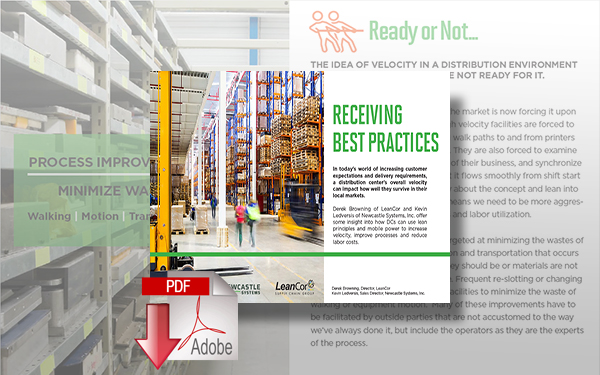Top Five Warehouse Management Problems and How to Fix Them

Warehouse management is commonly associated with six basic tenets: accuracy, cost control, efficiency, cleanliness, safety and security, but the underlying processes are complex and dynamic, presenting major problems for warehouse managers across industries.
Distributors have to deal with trade-offs due to resource limitations, leading to under performance in key functional areas.
Warehouse managers face the challenge of maximizing performance while balancing trade-offs under uncertain conditions. This article examines the top five warehouse management problems and their solutions.
Redundant Processes
Traditionally, warehouse employees have been likely to handle a product several times due to the nature of the warehousing process. This tendency lingers on in current practices. A notable redundant process in warehouses is where warehouse workers pass the same ticket through multiple hands.
While necessary in some instances, such redundant procedures are time-consuming and increase the cost of labor. Using barcode technology streamlines the warehousing process, removing redundant processes while maximizing resource utilization. Automated systems are evolving fast, a trend that compels warehouse managers to maintain up-to-date systems to achieve the desired results.
Poor Facility Layout
Efficient use of space is a critical success factor in warehousing. Inadequate storage space and inefficient use of available storage are common problems in warehouses with poor facility layout. Poorly configured warehouses are a major cause for worry for managers because of the inherent potential for negative impacts on profits.
The optimal layout factors both the floor space and the vertical space available for use. In addition to maximizing the use of space, a good layout maximizes the use of equipment and labor, accessibility to all items and the security of all items. Using forklifts that reach the roof of the warehouse allows for a configuration that maximizes both the horizontal and vertical space.
The complementary solution is to ensure that the highest-selling inventory is easily accessible by placing it at the most accessible point.
Seasonality in Demand
Fluctuations in demand pose serious challenges for warehouse managers. The dip in sales due to the recent global financial crisis resulted in major cost problems for warehouses due to increased inventory levels. Although it did not affect all industries alike, the problem highlights the challenge of fluctuations in demand due to forces outside the control of the warehouse.
Managing seasonality in demand requires timely and accurate information about manufacturing, retailing and the industry. Information gaps between the warehouse and other relevant entities or the industry limit the ability of the distributor to monitor and respond to changes in demand effectively. It is necessary for warehouses to use timely and accurate information in planning and forecasting demand as well as in providing supply chain visibility.
Rearranging the products to match changes in demand helps minimize the negative impacts of seasonal demand. Such a rearrangement involves correct positioning of the items by placing the products with high demand during the current season at the front of the picking aisle and at the correct height.
Dealing with seasonality in demand, however, goes beyond just layout and picking. The problem also requires proper management of transportation networks and strategic sourcing of transportation services. These long-term solutions build a lasting capability with strategic value for the distributor.
High Labor Costs
Warehouse managers strive to increase productivity while minimizing labor costs in a labor-intensive environment. Inbound Logistics estimates that labor constitutes about 65% of the operating budgets of most warehouses. A typical warehouse uses expensive equipment and employs a large labor force, presenting a challenge that is for the most part unique to warehousing operations.
The staff ranges from cleaners and packers to managers and administrative personnel. Attempts to reduce the cost of labor should take into consideration the impacts of the move on other costs. The two major strategies for addressing labor-related problems include maximizing available labor and replacing labor with automated systems.
Developing the right mix of expertise through workforce planning helps managers hone the skills necessary for successful labor force practices. A combination of the right skills and motivation, through practices such as excellent working conditions, training and flexible hours, enhances employee productivity and the performance of the warehouse.
Inaccurate Inventory
Accuracy and efficiency in handling inventory in warehousing go hand in hand. Inaccurate inventory causes problems such as maintaining improper stock levels and buildups of obsolete inventory. Picking problems also arise when pickers rely on inaccurate information, leading to inefficient processes. Other costs of inaccurate stock information include increased expenses, lost revenue and low productivity. Automation is a key factor in solving accuracy-related problems.
Automated systems offer real-time, accurate information about stock levels and composition. The technology employed in managing inventory in a warehouse is critical to success because the value of the automated system is just as good as the quality of the system itself. A low-quality system retains some of the risks associated with inaccurate inventory. A careful and informed selection process reduces the risk of procuring an automation system that does not meet the needs of the warehouse.
Warehouses face increasingly dynamic environments as remote events in the global supply chain become more relevant to local business environments. The desirable approach when dealing with the challenges that arise due to new developments is to use inexpensive solutions that offer sustainable best practices. Warehouse managers should monitor and track changes in the business environment and adopt responsive solutions.
Common warehouse problems such as redundant processes, poor facility layout, seasonality in demand, high labor costs and inaccurate inventory information require robust systems that keep managers informed about changes and gaps that require attention.
Related White Paper
Distribution Center Receiving Best Practices
In today's world of increasing customer expectations and delivery requirements, a distribution center’s overall velocity can impact how well they survive in their local markets. Download Now!
Article Topics
Newcastle Systems News & Resources
Reverse logistics in need of some love To Double Worker Productivity, Roll Out These Mobile Powered Carts by Newcastle Systems Hybrid Automation Blends Technology and Human Labor for Optimal Efficiency How this 3PL Eliminated Costly Labeling Errors: Problem, Solution, & Results Inflation’s Impact on Warehousing and the Supply Chain 10 Tips to Improve Your Warehouse Receiving Process Increase Warehouse Efficiency with These Technologies More Newcastle SystemsLatest in Warehouse|DC
North Carolina Welcomes Amazon’s Newest Mega-Warehouse SAP Unveils New AI-Driven Supply Chain Innovations U.S. Manufacturing is Growing but Employment Not Keeping Pace Maximize Warehouse Space with Mezzanine Automation: Expert Tips Most Companies Unprepared For Supply Chain Emergency Microsoft Unveils New AI Innovations For Warehouses Spotlight Startup: Cart.com is Reimagining Logistics More Warehouse|DC















